
The McDonnell FH Phantom is a twinjet, straight-wing, carrier-based fighter aircraft designed and first flown during late World War II for the United States Navy. As a first-generation jet fighter, the Phantom was the first purely jet-powered aircraft to land on an American aircraft carrier and the first jet deployed by the United States Marine Corps. Although only 62 FH-1s were built it helped prove the viability of carrier-based jet fighters. As McDonnell's first successful fighter, it led to the development of the follow-on F2H Banshee, which was one of the two most important naval jet fighters of the Korean War; combined, the two established McDonnell as an important supplier of navy aircraft.

The McDonnell XF-88 Voodoo was a long-range, twinjet fighter aircraft with swept wings designed for the United States Air Force. Although it never entered production, its design was adapted for the subsequent supersonic F-101 Voodoo.
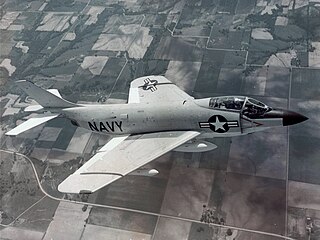
The McDonnell F3H Demon is a subsonic swept-wing carrier-based jet fighter aircraft designed and produced by the American manufacturer McDonnell Aircraft Corporation. It was the first swept wing jet fighter and the only single-engined carrier-based fighter the company produced.
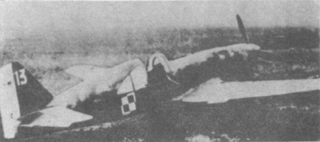
The C.710 were a series of light fighter aircraft developed by Caudron-Renault for the French Air Force just prior to the start of World War II. One version, the C.714, saw limited production, and were assigned to Polish pilots flying in France after the fall of Poland in 1939. A small number was also supplied to Finland.

The Douglas Y1B-7 was a 1930s American bomber aircraft. It was the first US monoplane given the B- 'bomber' designation. The monoplane was more practical and less expensive than the biplane, and the United States Army Air Corps chose to experiment with monoplanes for this reason. At the time the XB-7 was ordered, it was being tested by Douglas Aircraft as an observational plane.

The Bell XP-77 development was initiated by the United States Army Air Forces during World War II to produce a simplified "lightweight" fighter aircraft using non-strategic materials. Despite being innovative, the diminutive prototype proved tricky to handle and the project was canceled when the XP-77 did not deliver its projected performance.

The Curtiss XP-46 was a 1940s American prototype fighter aircraft. It was a development of the Curtiss-Wright Corporation in an effort to introduce the best features found in European fighter aircraft in 1939 into a fighter aircraft which could succeed the Curtiss P-40, then in production.

The Curtiss P-60 was a 1940s American single-engine single-seat, low-wing monoplane fighter aircraft developed by the Curtiss-Wright company as a successor to their P-40. It went through a lengthy series of prototype versions, eventually evolving into a design that bore little resemblance to the P-40. None of these versions reached production.

The Grumman XP-50 was a land-based development of the shipboard XF5F-1 Skyrocket fighter, entered into a United States Army Air Corps (USAAC) contest for a twin-engine heavy interceptor aircraft. The USAAC placed an order for a prototype on 25 November 1939, designating it XP-50, but it lost the competition to the Lockheed XP-49.

The McDonnell XP-67 "Bat" or "Moonbat" was a prototype for a twin-engine, long-range, single-seat interceptor aircraft for the United States Army Air Forces. Although the design was conceptually advanced, it was beset by numerous problems and never approached its anticipated level of performance. The project was canceled after the sole completed prototype was destroyed by an engine fire.

The Lockheed XP-58 Chain Lightning was an American long-range fighter developed during World War II. Although derived from the successful P-38 Lightning, the XP-58 was plagued by technical problems with its engines that eventually led to the project's cancellation.
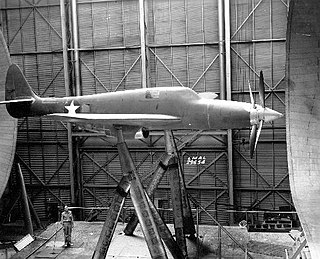
The Republic XP-69 was an American fighter aircraft proposed by Republic Aviation in 1941 in response to a requirement by the United States Army Air Corps for a high-speed fighter. Manufacturers were encouraged to consider unorthodox designs; although the design was ordered as a prototype it was canceled because of delays with the engine that was to power it.

Tucker XP-57 was the designation of a lightweight fighter which was proposed to the United States Army Air Corps (USAAC) in 1940. Nicknamed the "Peashooter", it was developed by the Tucker Aviation Corporation under Preston Tucker, who later became famous for the Tucker '48 Sedan.
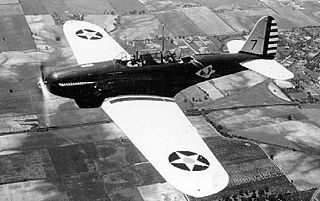
The Consolidated P-30 (PB-2) was a 1930s United States two-seat fighter aircraft. An attack version called the A-11 was also built, along with 2 Y1P-25 prototypes and YP-27, Y1P-28, and XP-33 proposals. The P-30 is significant for being the first fighter in United States Army Air Corps service to have retractable landing gear, an enclosed and heated cockpit for the pilot, and an exhaust-driven turbo-supercharger for altitude operation.
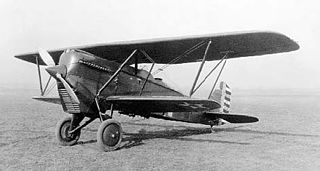
The Boeing XP-7 was a prototype United States biplane fighter of the 1920s.

The Boeing XP-15 was an American prototype monoplane fighter.
The Hughes D-2 was an American fighter and bomber project begun by Howard Hughes as a private venture. It never proceeded past the flight testing phase but was the predecessor of the Hughes XF-11. The sole D-2 was completed in 1942–1943.
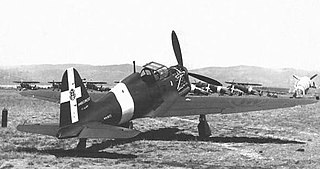
The Ambrosini SAI.207 was a light fighter interceptor and developed in Italy during World War II. Developed from the pre-war SAI.7 racing aircraft it was built entirely from wood, Powered by a single 750 hp Isotta Fraschini Delta, the SAI.207 enjoyed limited success during evaluation of the 12 pre-production aircraft.

The Lockheed L-133 was an exotic design started in 1939 which was proposed to be the first jet fighter of the United States Army Air Forces (USAAF) during World War II. The radical design was to be powered by two axial-flow turbojets with an unusual blended wing-body canard design capable of 612 mph (985 km/h) in level flight. The USAAF rejected the 1942 proposal, but the effort speeded the development of the USAAF's first successful operational jet fighter, the P-80 Shooting Star, which did see limited service near the end of war. The P-80 was a less radical design with a single British-based Allison J33 engine, with a conventional tail.

The Vought V-141 was a prototype American single-seat fighter aircraft of the 1930s. It was a development of the unsuccessful Northrop 3-A design, but was itself a failure, being rejected by the United States Army Air Corps. The sole prototype was sold to the Japanese Army in 1937, but no production followed, with the type proving to be inferior to existing Japanese fighters.



















